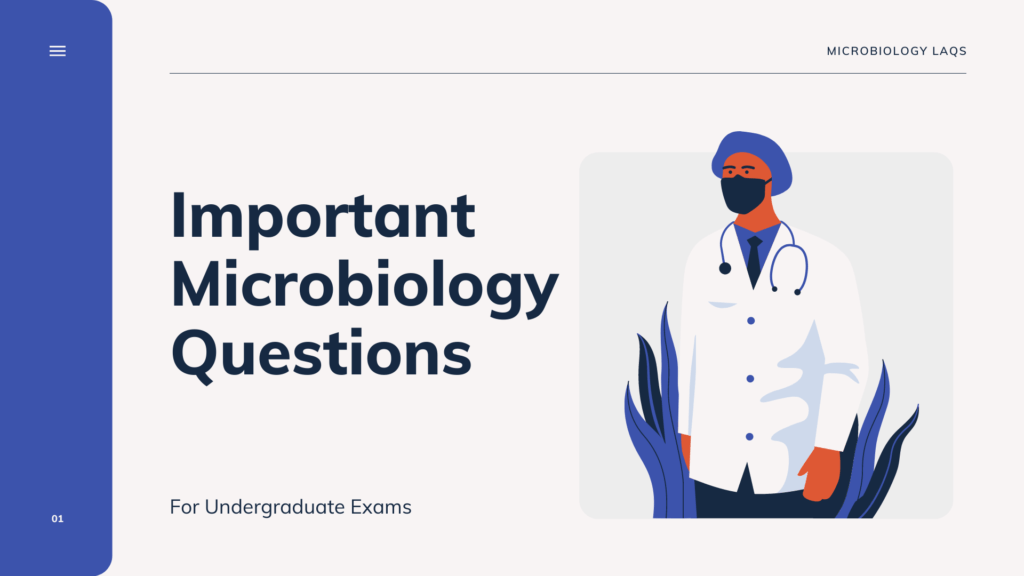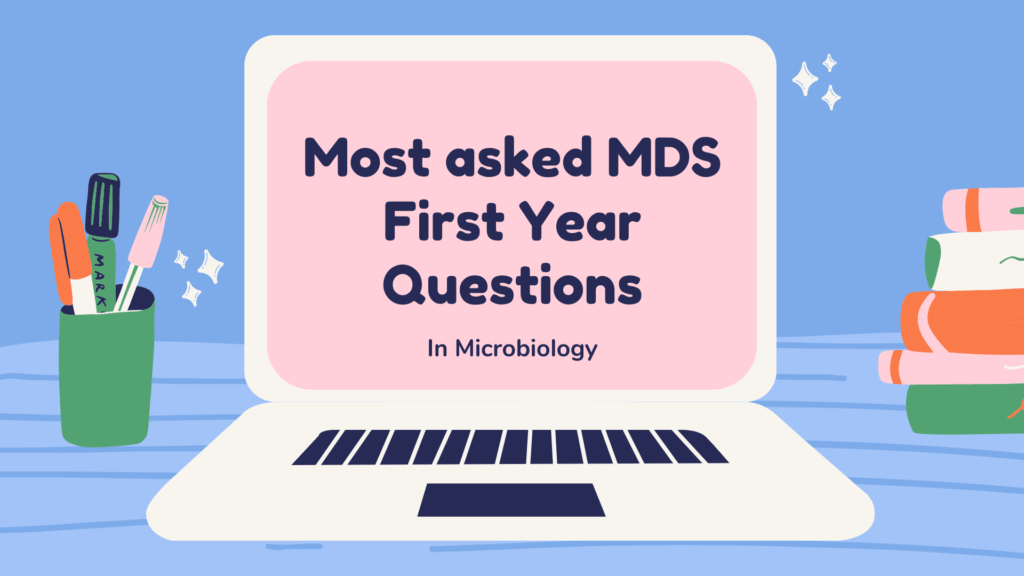Hello, I’m pleased to give you this exhaustive list of the most Important Long Answer Questions (LAQ) Microbiology Questions for BDS Exam in the past years from all over the universities in India. Remember, this is not a complete list and we shall keep on adding new questions as soon as we find them. You can comment below questions/topics which your university has asked if it is missing and we shall add that too. Do check the DCI syllabus and prepare accordingly.
Below is the list of questions from Microbiology
Sterilization
- Define sterilization. List the methods of sterilization. Discuss their applications in medical practice.
- Define sterilization. Classify and describe the various methods of moist heat sterilization. Add a note on sterilization of the operation theater in your hospital.
- Define sterilization. Classify the methods of sterilization by moist heat. Describe the method of sterilization by steam under pressure.
- Define and classify sterilization. Describe (discuss in detail) moist heat methods of sterilization.
- Define sterilization and disinfection. Write in detail about chemical disinfectants. Enumerate the methods of testing disinfectants.
Hypersensitivity Reaction
- Classify hypersensitivity reactions. Discuss the pathogenesis, clinical features, and management of anaphylaxis. Add a note on atopy.
- Define hypersensitivity. Classify/List its types. Give an account of Type I hypersensitivity (discuss in detail).
- Classify hypersensitivity reactions. Describe the pathogenesis of Type I hypersensitivity reaction.
Mycobacterium Tuberculosis
- Describe the morphology, cultural characteristics, and laboratory diagnosis of Mycobacterium tuberculosis.
- Classify mycobacteria. Describe the laboratory diagnosis of pulmonary tuberculosis.
- Classify mycobacteria. Describe the etiopathogenesis and laboratory diagnosis of pulmonary tuberculosis/tuberculosis. Add a note on the prophylaxis of tuberculosis.
Vibrio Cholerae
- Enumerate the organisms causing diarrhea. Describe the morphology, cultural characteristics, laboratory diagnosis, and prevention of Vibrio cholera.
- Classify Vibrios. Describe the pathogenesis, laboratory diagnosis, and management of cholera.
- Enumerate the bacteria causing acute gastroenteritis. Describe the pathogenesis, laboratory diagnosis, and prophylaxis of cholera.
Clostridia
- Classify Clostridia. Describe the pathogenesis, laboratory diagnosis, and prophylaxis of (clostridial) gas gangrene.
Immunity
- Define and classify immunity. Write in detail about active immunity.
- Classify immunity. Describe the various types of acquired immunity citing suitable examples.
- Describe in detail the anatomy of the bacterial cells.
- Classify bacteria according to their shape, citing examples. Describe the bacterial growth curve.
- Describe the structure of a bacterial cell with suitable diagrams.
- Classify Streptococci. Describe the pathogenicity and laboratory diagnosis of Streptococcus pyogenes.
- Classify Streptococci. Write in detail about Group A Streptococcus giving their cultural characteristics, pathogenesis, and laboratory diagnosis.
- Classify Streptococci. Describe the toxins, enzymes, and infections produced by Streptococcus pyogenes. Add a note on the laboratory diagnosis of streptococcal infections.
- Classify Enterobacteria. Describe the laboratory diagnosis of typhoid fever.
- Enumerate the bacteria causing enteric fever. Discuss the etiology, pathogenesis, laboratory diagnosis, and prophylaxis of enteric fever.
Bacteria
- Enumerate the bacteria causing meningitis. Describe the pathogenesis, laboratory diagnosis, and prophylaxis of pneumococcal meningitis.
- Enumerate the organisms causing bacterial meningitis. Describe the morphology, cultural characteristics, pathogenesis, laboratory diagnosis, and prevention of any one of them.
- Enumerate the antigen-antibody reactions. Describe (in detail) agglutination reactions with suitable examples. Add a note on their clinical applications.
- Name the different Spirochaetes and the diseases caused by them. Describe the laboratory diagnosis of syphilis.
- Classify Spirochaetes. Describe the pathogenesis and laboratory diagnosis of syphilis.
- Enumerate the methods of transfer of genetic material in bacteria. Explain in detail – Transformation.
Immunoglobulins
- Classify immunoglobulins. Describe the structure, and functions of each of the classes of immunoglobulins.
Protozoa
- Enumerate the species of malarial parasites/protozoan parasites infecting (pathogenic to) human beings. Describe the morphology, pathogenesis, life cycle, complications, laboratory diagnosis, treatment, and prevention of Plasmodium falciparum (malarial parasite).
Viruses
- Classify/Enumerate Hepatitis viruses. Describe the morphology, pathogenesis, complications, laboratory diagnosis, and prophylaxis of hepatitis B.
- Classify Retroviruses. Describe in detail the structure (morphology with diagram), pathogenesis, clinical features, laboratory diagnosis, treatment, and prevention of Human Immunodeficiency Virus (HIV) infection/acquired immunodeficiency syndrome (AIDS).
- Classify Picornaviruses/Enteroviruses. Describe the pathogenesis, clinical findings, laboratory diagnosis, and prophylaxis of poliomyelitis.
Nematodes
- Enumerate the Intestinal nematodes. Describe the life cycle of Ascaris lumbricoides. Explain the pathogenesis, laboratory diagnosis, and complications of ascariasis.
- Classify Nematodes based on their habitat. Outline the life cycle of Ancylostoma duodenale. Describe the pathogenesis, clinical features, laboratory diagnosis, and prevention of ancylostomiasis (hookworm
infection) - Describe the morphology, pathogenesis, life cycle, laboratory diagnosis, and prophylaxis of Echinococcus granulosus (hydatid disease).
- Describe the pathogenesis, laboratory diagnosis, and prophylaxis of rabies.
- Classify Nematodes. Discuss the geographical distribution, habitat, life cycle, pathogenicity (pathogenesis), clinical features, and laboratory diagnosis of Wuchereria bancrofti /lymphatic filariasis.
Miscellaneous
- Describe the morphological forms, life cycle, pathogenesis, clinical features, and laboratory diagnosis of Entamoeba histolytica /intestinal amoebiasis.
- Classify Herpes viruses. Describe the pathogenesis and laboratory diagnosis of Herpes Simplex Type I/herpes simplex virus (HSV) infections.
- Enumerate the Arboviruses in India. Describe the pathogenesis, laboratory diagnosis, and prevention of dengue fever.
If you are looking for Microbiology Important Questions for First Year MDS, click this link.
Microbiology is one of the important subjects to help you succeed as a dentist. If you find some questions of Microbiology missing, do let us know via commenting in the section below and we shall add those questions too. These important Microbiology questions might come in handy when you are preparing for your BDS Exam.
Last updated on June 13th, 2021 at 23:01


